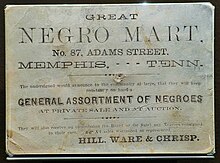





Forrest's jail was the slave pen owned and operated by Nathan Bedford Forrest in Memphis, Tennessee, United States. Forrest bought 87 Adams Street, located between Second and Third, in 1854.[2] It was located next to a tavern that operated under various names,[2] opposite Hardwick House,[7] and behind the still-extant Episcopal church.[8] Forrest later traded, for fewer than six months, from 89 Adams.[6] Byrd Hill bought 87 Adams in 1859.[6] An estimated 3,800 people were trafficked through Forrest's jail during his five years of ownership.[9]
- ^ "The Old Negro Mart". The Commercial Appeal. January 27, 1907. p. 48. Retrieved 2023-12-01.
- ^ a b c Hurst, Jack (1993). Nathan Bedford Forrest: A Biography. New York: Alfred A. Knopf. pp. 37–38, 56–60. ISBN 978-0-307-78914-3. LCCN 92054383. OCLC 26314678.
- ^ "Are we to have a new jail?". Daily Union Appeal. August 16, 1862. p. 3. Retrieved 2023-12-01.
- ^ "Directors, Bank of West Tennessee". Memphis Daily Appeal. March 7, 1861. p. 3. Retrieved 2023-12-14.
- ^ "Personal". The Daily Memphis Avalanche. December 21, 1875. p. 4. Retrieved 2023-12-14.
- ^ a b c Cite error: The named reference
Huebner2023was invoked but never defined (see the help page). - ^ "Removal of the station house". Daily Union Appeal. August 28, 1862. p. 3. Retrieved 2023-12-04.
- ^ "The Butcher Forrest and His Family: All of them Slave Drivers and Woman Whippers". Chicago Tribune. May 4, 1864. p. 3. Retrieved 2023-12-04.
- ^ Colby, Robert K. D. (2024). An Unholy Traffic: Slave Trading in the Civil War South. Oxford University Press. p. 54. doi:10.1093/oso/9780197578261.001.0001. ISBN 9780197578285. LCCN 2023053721. OCLC 1412042395.